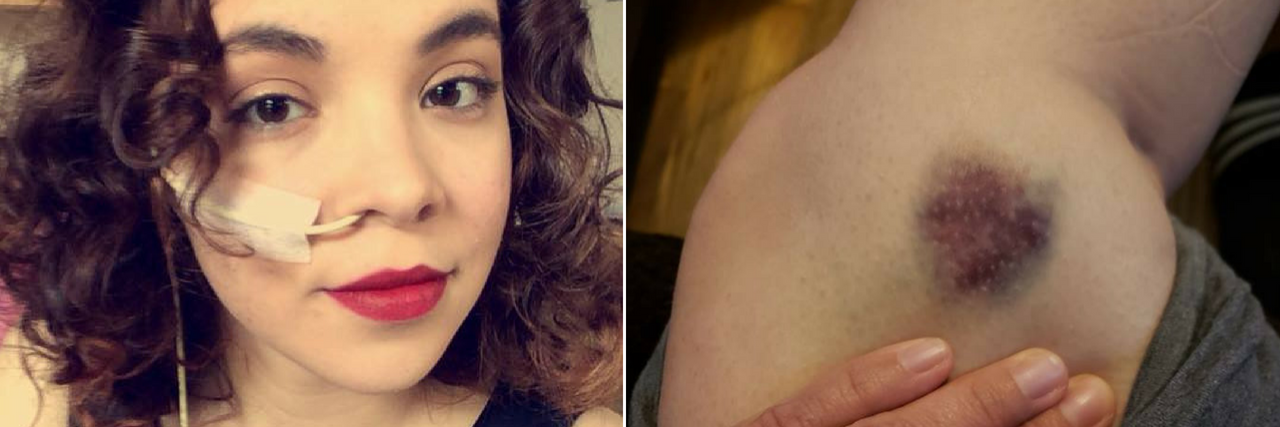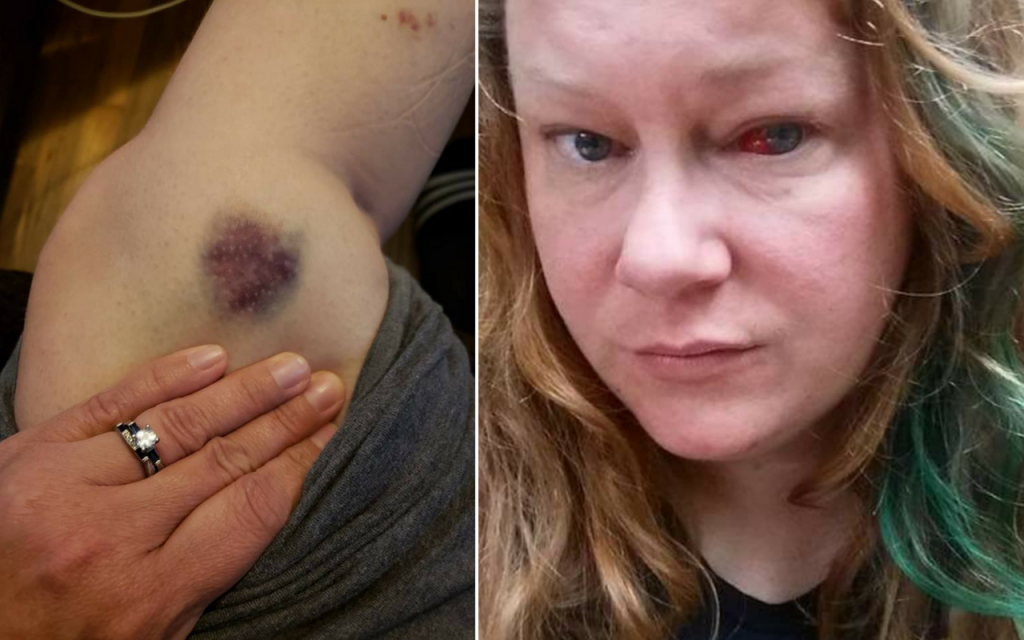Ehlers-Danlos syndrome (EDS) may often be known for symptoms such as joint hypermobility or skin fragility – but EDS is a complex condition with 13 subtypes, so it can produce a wide range of symptoms and side effects that aren’t often talked about. Side effects can range from physical issues that result from symptoms of the illness, to comorbid conditions, to the effects living with EDS can have on your lifestyle or mental health.
• What is Ehlers-Danlos Syndrome?
• What Are Common Ehlers-Danlos Syndrome Symptoms?
It’s important to recognize and talk about the lesser-known side effects of EDS so those with the condition can be better supported by loved ones, and better understood and treated by doctors. So, we asked our Mighty community to share a photo of a side effect of EDS they experience that’s not often talked about. Perhaps you’ll recognize some of your own experiences in the photos below.
Here’s what our community shared with us:
1. “[Left:] Spontaneous vascular rupture. I was standing and talking to family. I felt a nauseating tearing sensation and watched a hematoma grow. This has happened multiple times in various vascular structures including my eyes. [Right:] Photo of spontaneous subconjunctival hemorrhage. This happened while I was driving. All I felt was a twinge of pain in my eye, looked in the mirror when I got home and saw this.” – Stephanie S.
2. “Urinary retention. I rely on a catheter to empty my bladder now. I also have trouble regulating my temperature. Right now, even though the temperature is mild and I’m only wearing boxers and a T-shirt, I’m having a ‘hot flash’ and sweating like crazy! Other times it’ll be my body overreacting to temperatures, so burning hot flashes in winter and suddenly becoming really, really cold in the height of summer! It’s more annoying than problematic though.” – Dylan H.
3. “Gastroparesis from my POTS that is caused by EDS. It’s all connected.” – Alexis M.
4. “I lost my hearing because of EDS. I was 26 when I first started wearing hearing aids. I was 41 when I was diagnosed with Ehlers-Danlos.” – Colleen C.
5. “My pain flares exploding all over my back. It hurts sooo much.” – Lindsey B.
6. “Most people don’t talk about how our incredibly high pain tolerance can actually be damaging. This is me after my most recent surgery. It was just supposed to be a simple surgery to remove a calcium deposit. When my doctor got in there he discovered it ate a hole through my rotator cuff. If it wasn’t for my high pain tolerance, I probably would have noticed something was wrong before I had a hole in my rotator cuff.” – Sandi D.
7. “Everyone always talks about how the hypermobility causes dislocations and subluxations, but never/rarely about hyperextensions. That’s a semi-frequent problem I have in my knees because of how hypermobile they are and honestly those hurt more than dislocations.” – Kourteney K.
8. “The ‘hidden talent’ also known as Gorlin’s sign. Basically, a hypermobile tongue.” – Tori M.
9. “An invisible side effect of Ehlers-Danlos syndrome is another condition called gastroparesis. Gastroparesis is delayed emptying of the stomach. Here is a picture of me eating a salad which is something I had not been able to eat for two years due to a restricted diet from gastroparesis. Many ‘normal’ people take the little things in life for granted, but living with Ehlers-Danlos has taught me to never take anything for granted. Eating a salad may seem so small in the grand scheme of things, but for me being able to eat raw foods again has changed my life.” – Anita D.
10. “Massive bruise to my right inner lower thigh. Not an area that I usually bump when I walk into walls… LOL. Still have no idea how it happened.” – Denise D.
11. “Vascular problems are invisible in EDS, unless on medical imaging like this. I went in for an MRI for widespread nerve pain and thoracic pain. There are a few disc herniations in the t-spine and a significant one at L5-S1 (EDS favorite places are my spine, my stomach and upper body). To the neurologist’s surprise, they found a spinal dural arteriovenous fistula. These are incredibly rare, especially for my demographic. I was sent to a neurovascular specialist who said I was the second one he’d ‘seen’ in person. It’s stable right now but requires yearly MRIs to monitor. If I develop neurologic symptoms (beyond just nerve pain, which can be managed), then it will need to be surgically fixed immediately as it can lead to irreversible damage and cause things like paralysis.” – Kristy G.
12. “Craniocervical instability! I wear this brace to try and avoid getting a spinal fusion. I use it the same way that I would use a knee or wrist brace, too. It confuses people so bad. They don’t understand what’s wrong and constantly ask if I have been in an accident. But it’s just my C2 and C3 deciding to be a bit too loose, and constantly moving! It causes pain, nausea, difficulty swallowing, etc. So blessed to be able to use a brace to help those symptoms lessen!” – Catherine M.
13. “This is so rarely discussed, I didn’t know it was a symptom until recently – skin that is easily damaged, bruised, injured and does not heal well. My skin has been a source of embarrassment for me for years. Even the dermatologist told me I just needed to ‘pick at it less.’ My skin looks like this without any ‘picking’ and it hurts.” – Sarah A.
14. “Laying in bed after my POTS from EDS caused my blood pressure to become so low that I had two seizures while napping.” – Layli M.D.
15. “Blue sclera – the whites of the eyes have a blue hue to them because the corneas become very thin. The eye is 90 percent collagen.” – Leanne J.
16. “Hypermobile feet cause tremendous pain from the joints stretching. I use some Salonpas patches even on my arch (not seen in pic) and my achilles tendon. My calf starts spasming and cramping and there is really not much to do to help the foot area. Yet we need our feet to hold us up.” – Danyce S.
17. “My scars widen and look unusual.” – Megan M.
18. “Piezogenic papules, subcutaneous fat herniates through my skin on my heels when I am on my feet too long. They become painful from rubbing on my shoes. My feet bother me so much.” – Megan C.
19. “EDS has affected my body in many ways, especially my heart and brain. With connective tissue being so weak and not much to hold organs in place I’ve received multiple traumatic brain injuries (TBI). I’m so susceptible that just hitting a pothole going down the road can cause another. Over time these TBIs have taken their tole on the cerebrum portion of my brain leaving me paralyzed. I was attempting to learn to walk again but have recently been told, due to osteoporosis which also resulted from EDS, it’s no longer safe for me to even try to learn to walk again. It’s rare to be paralyzed, ultimately, from EDS but can happen. I’m living proof.” – Jamie H.



















